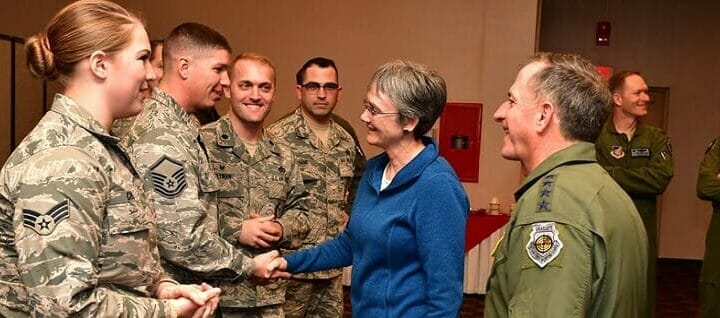Air Force Secretary Heather Wilson delivered the keynote address to the Air Force Association’s Air, Space & Cyber Conference just outside of Washington, D.C. , and dropped a bomb on the planning, programming, budget, and execution process. Wilson called for a massive increase in the size of the U.S. Air Force, expanding by as many as 40,000 airmen who would fill the ranks of 74 new operational squadrons.
Telling the crowd that the Air Force needs “take stock of where we are, so that we can reaffirm where we need to go,” Wilson argued that the current air force is too small to accomplish the missions the nation has asked it to accomplish.
air force would need a very large blank check to expand like this
But surely Wilson, a former Member of Congress, knows that asking for a 40,000-person increase in end strength by 2030 is simply unworkable. I’m a defense hawk’s defense hawk, and I realize there’s no way this is happening. Much like the push for a 355-ship Navy, a 386-operational-squadron air force is not going to happen in the current – or any other – fiscal environment.
Todd Harrison is the director of the Aerospace Security Project and a defense budget analyst at the Center for Strategic and International Studies, a prominent Washington think tank. Since Wilson did not discuss costs, Harrison filled in the blanks. The cost of adding 40,000 bodies to the USAF would cost an estimated $5.2 Billion per year. And all these new squadrons would cost an additional $13 Billion a year to operate and maintain.
We haven’t even begun to discuss the cost of the actual aircraft for these units. A USAF fighter squadron has 24 aircraft. The current cost of a single F-35A fighter is $85 million. That’s a procurement cost of $2 billion per squadron. The Air Force wants seven new fighter squadrons. That’s a total cost of $14.28 billion.
And now we haven’t discussed where we’re going to find the people to fly these planes. As recently as last October, the air force was short more than 1,000 pilots to fly the planes it already has. Now it wants more planes before it has solved its current pilot problem.
impending space force and the battle of the budgets
President Donald Trump’s desire to create a space force as the sixth armed service has clearly rattled the leadership of the U.S. Air Force. They know that the bulk of any space force will be organizations cut from its ranks, including its 16 Space Operations Squadrons. And when the air force feels threatened, it tries to go on a spending spree, since in “The Pentagon Games,” whoever has the biggest budget wins.
I witnessed this firsthand 11 years ago when the service tried to grab control of all unmanned aerial systems that flew above 3,500 feet. The Army fought tooth-and-nail against the proposal, which would have stripped it of all UAS except the small, hand-launched Raven. The Army agreed, ultimately successfully, that it it needed to retain its MQ-1C Sky Warrior (essentially the same aircraft as the Air Force’s MQ-1B Predator) for the valuable manned-unmanned teaming missions that were saving American lives in Iraq at a very dangerous time.
Conversely, the Air Force believed that using a Predator in what was essentially a close air support role was a waste of a theater-level asset. For that reason alone, I have no faith in the Air Force’s assurances that it can retire the A-10 “Warthog” and cover the mission with the F-35 Lightning II. The Air Force culture is dominated by fighter pilots. Fighter pilots exist to shoot down other airplanes, especially other fighters. Shooting bad guys on the ground simply isn’t sexy enough.
Air force leadership is misunderstanding its purpose
But there is one inescapable truth of warfare that hasn’t changed since the first clan of cavemen squared-off against another: wars are won by infantrymen. Everything else in the national arsenal (with the possible exception of strategic nuclear weapons) is designed in one way or another to support the wet, cold, and tired young man (and nowadays, young woman) with a rifle and a rucksack whose job is to slog through the mud and kill another human being “up close and personal.”
For all the advances in military technology, we still wear armor, live inside castle walls when we’re not fighting, and fight face-to-face. I don’t mean to denigrate my friends in blue. The Air Force fulfills a vital role in war. Besides providing close air support, it can strike at deep enemy targets, and prevent the enemy’s aircraft from providing close air support to its own troops, or from striking our own deep targets.
But the Army also relies on the Air Force, in many cases, to get to the theater of operations, and in the case of the airborne, to get to the battle itself. Yet Wilson’s proposal only includes one additional airlift squadron.
USAF leadership long ago lost the bubble on where their force should be applied. Wilson’s proposal doesn’t fill me with confidence that its leadership understands what the infantryman needs from it.


